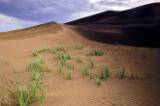Disappearing Landscapes
Habitat loss and fragmentation have drastically reduced the quality and quantity of several ecosystems whose absence makes them loom even larger in American mythology — the once vast longleaf pine savannas of the Southeast, tallgrass prairie stretched like an inland sea.
The decline of these landscapes, whether through degradation or outright conversion to other uses, brings with it real losses in biodiversity through the reduction of their unique habitats, natural communities, and dynamic processes.
Key Endangered Ecosystems
-
Longleaf Pine
Described by 18th-century naturalist William Bartram as "a vast forest of the most stately pine trees that can be imagined, the longleaf pine ecosystem today occurs on less than 2 million acres -- a 97% decline that represents one of the most drastic reductions of any of the United States' major ecosystems.
-
Tallgrass Prairie Ecosystem
In the early years of westward expansion, the vast expanses of tallgrass prairie awed eastern settlers, who were equally amazed that people who appeared to be walking through the prairie in the distance were actually on horseback.
-
Ponderosa Pine Ecosystem
Romanticized in television, books, and film, the Ponderosa pine ecosystem is instantly recognizable to the many Americans who strongly associate these woodlands or ¿savannas¿ of tall, widely spaced pine trees with the mountains of the Southwest.
Go Straight to Your State
Learn about conservation and open space in your state.






